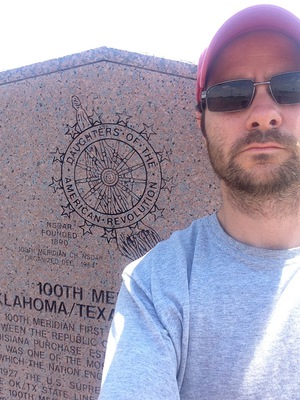Coughlin explores identity along 100th Meridian

CHADRON – A youthful fascination with the western United States that started in an elementary school social studies class was part of what brought Massachusetts native Dr. Steve Coughlin, who is now in his fifth year as an assistant professor of English at Chadron State College, to the high plains of northwest Nebraska.
In the summer of 2017 the persistent lure of the American West, combined with a delight in cross-country road trips, led Coughlin on a 2,000-plus mile journey of exploration from Canada to Mexico along the 100th Meridian, a trip he plans to chronicle for an online literary magazine and possibly in book form.
The 100th Meridian is often viewed as the geographic, environmental and cultural dividing line between the eastern and western United States. Though its location bisecting the North American continent is arbitrary and based on an 18th century map system developed to aid European sailors, the meridian line is significant because of the ways is has shaped our ideas about the West, Coughlin said.
“Look at the mythos that came out of it,” he said. “There is nothing more American than the cowboy and the beginning of that is through an arbitrary line.”
The idea of a border-to-border journey along that arbitrary line on a map came in part from frustration with people who, upon learning Coughlin is from Nebraska, believe that he lives in the Midwest.
“I don’t (live in the Midwest). We are west of the 100th Meridian,” Coughlin said. “I never liked the Midwest. That’s one part of the country that did not excite me.”
Teaching CSC students about travel writing in a creative non-fiction writing course provided another motivation, said Coughlin, whose second book of poetry, “Driving at Twilight,” is set for publication in December.
“We were talking about travel writing. I’ve published a lot of memoir essays, but never a travel narrative,” he said. “I ask my students to write these things, so I need to do one myself.”
A grant from the CSC Faculty Senate Research Institute Committee provided funding for the trip, which took Coughlin from the Canadian border in North Dakota south to Laredo, Texas, the city on the Mexican border closest to the 100th Meridian. Driving that 1,700 mile span, mostly along U.S. Highway 83, Coughlin made a point of visiting both sides of the 100th Meridian, and stopping in many of the small towns that lie in the sparsely populated center of the country.
“I really got a vibe about what life is like along the 100th Meridian,” he said. “You go on one side and you could see the rain belt; you don’t get as much (rain) on the western side.”
Contrasts in land use, with farmland dominant on the east and ranch country on the west, were also noticeable, and Coughlin discovered that towns on the eastern side tended to be slightly larger.
Common features on both sides of the meridian also emerged during the trip.
“Every town had a frontier something. Every town had a pioneer something,” he said. “You start to see the language of the West.”
The small museums found in many of the communities along the route fascinated Coughlin. “Every little town has its museum,” he said. “People want to put something into the town so you know that they were there.”
A planned visit to the 100th Meridian Museum in Erick, Oklahoma, went awry because it was closed when Coughlin arrived, but he was delighted to find nearby an unusual museum dedicated to country singer Roger Williams.
The Museum of the High Plains in McCook, Nebraska, which features hundreds of mannequins dressed in clothing typical of the area in different times, forms a central piece of Coughlin’s essay about his journey.
“It (the museum) is making a claim that for whatever period of time, whatever happens, we were here. We existed and our lives mattered,” he said.
Coughlin said he filled a journal with notes while on the trek, and began to think about the importance of maps to his project.
“What I realized (was) this is about my love of maps,” he said. “It became an ode to cartography.”
Analyzing different concepts about the American West was another theme that emerged from the journey, one that Coughlin wrote about as part of a series titled “What is the West” published by High Desert Journal an online literary and fine arts magazine.
That short essay forms the opening paragraph of a much longer piece Coughlin is still in the process of revising for publication, possibly in book form.
“This is an essay, but it’s really a book project,” he said.
For now, though, Coughlin remains busy with teaching, helping his wife Tamara take care of their now nearly six-month-old daughter, and other writing projects, including another collection of poetry.
But the trip has awakened a desire for more travel and travel writing.
“It was a fascinating experience, and writing about it is fascinating,” Coughlin said. “I want to trace the 100th Meridian further. I want to keep exploring.”
And the journey has served to increase Coughlin’s appreciation of the region that inspired his imagination back in social studies class in Massachusetts.
“The High Plains are the epitome of imaginative space. The landscape is open. It kind of feeds your spirit. It feeds your soul,” he said. “There is no place that is more full of imaginative possibilities.”
Category: Campus News


